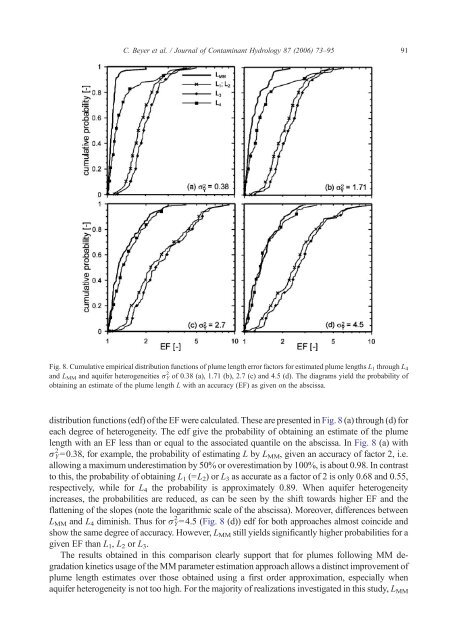Applied numerical modeling of saturated / unsaturated flow and ...
Applied numerical modeling of saturated / unsaturated flow and ...
Applied numerical modeling of saturated / unsaturated flow and ...
Create successful ePaper yourself
Turn your PDF publications into a flip-book with our unique Google optimized e-Paper software.
C. Beyer et al. / Journal <strong>of</strong> Contaminant Hydrology 87 (2006) 73–95<br />
Fig. 8. Cumulative empirical distribution functions <strong>of</strong> plume length error factors for estimated plume lengths L1 through L4<br />
<strong>and</strong> LMM <strong>and</strong> aquifer heterogeneities σY 2 <strong>of</strong> 0.38 (a), 1.71 (b), 2.7 (c) <strong>and</strong> 4.5 (d). The diagrams yield the probability <strong>of</strong><br />
obtaining an estimate <strong>of</strong> the plume length L with an accuracy (EF) as given on the abscissa.<br />
distribution functions (edf) <strong>of</strong> the EF were calculated. These are presented in Fig. 8 (a) through (d) for<br />
each degree <strong>of</strong> heterogeneity. The edf give the probability <strong>of</strong> obtaining an estimate <strong>of</strong> the plume<br />
length with an EF less than or equal to the associated quantile on the abscissa. In Fig. 8 (a) with<br />
σY 2 =0.38, for example, the probability <strong>of</strong> estimating L by LMM, given an accuracy <strong>of</strong> factor 2, i.e.<br />
allowing a maximum underestimation by 50% or overestimation by 100%, is about 0.98. In contrast<br />
to this, the probability <strong>of</strong> obtaining L1 (=L2)orL3 as accurate as a factor <strong>of</strong> 2 is only 0.68 <strong>and</strong> 0.55,<br />
respectively, while for L4 the probability is approximately 0.89. When aquifer heterogeneity<br />
increases, the probabilities are reduced, as can be seen by the shift towards higher EF <strong>and</strong> the<br />
flattening <strong>of</strong> the slopes (note the logarithmic scale <strong>of</strong> the abscissa). Moreover, differences between<br />
LMM <strong>and</strong> L4 diminish. Thus for σY 2 =4.5 (Fig. 8 (d)) edf for both approaches almost coincide <strong>and</strong><br />
show the same degree <strong>of</strong> accuracy. However, LMM still yields significantly higher probabilities for a<br />
given EF than L1, L2 or L3.<br />
The results obtained in this comparison clearly support that for plumes following MM degradation<br />
kinetics usage <strong>of</strong> the MM parameter estimation approach allows a distinct improvement <strong>of</strong><br />
plume length estimates over those obtained using a first order approximation, especially when<br />
aquifer heterogeneity is not too high. For the majority <strong>of</strong> realizations investigated in this study, L MM<br />
91

















